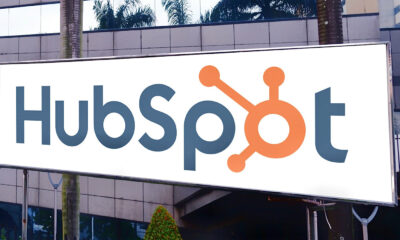SEO
5 Steps To Succeed With Full Funnel Marketing
As a business-to-business (B2B) marketer, you need a well-structured B2B multichannel funnel strategy.
This will help you attract new customers, generate leads, and land sales.
Without a full-funnel marketing approach, you can kiss your efficacy at brand awareness, lead generation, and sales revenue goodbye.
The B2B marketing funnel involves a multichannel funnel strategy in four stages.
The first three focus on acquiring a new customer, and the final retention stage focuses on customer loyalty.
- Top of the funnel (TOFU): This is mostly focused on brand awareness and prospect generation.
- Middle of the funnel (MOFU): This consideration phase is primarily focused on lead generation.
- Bottom of the funnel (BOFU): This is where the deal is closed and moves on to the sales team.
- Customer retention: This phase focuses on keeping existing customers happy, generating repeat business, and working with referrals.
What’s Unique About The B2B Funnel?
The sales funnel is not new information to you, nor is it unique to your marketing team.
Most digital marketing professionals use some version of full-funnel marketing as part of their sales and marketing efforts.
However, unlike most B2C companies, the B2B sales cycle is often much longer than your consumer-facing counterpart and typically requires a more refined approach.
B2B companies often have to nurture their prospects for many more months than B2C companies before they become paying customers.
They also have a different decision-making process for B2C consumers.
Unlike B2C customers, the B2B buyer is searching for a solution that solves an organizational problem, such as profit, productivity, and competitiveness.
After passing through several internal processes and sign-offs, a group usually makes the final purchase decision or approval process.
B2B buyers tend to use greater logic, fact-based reasoning, and in-depth research than B2C buyers before landing on a purchase decision.
For this reason, a well-devised marketing funnel that guides the buyer along the sales journey is of massive importance for B2B marketers who want to succeed.
So, what’s the problem?
Tunnel (Not Funnel) Vision
Growth marketers are under tremendous pressure to meet deadlines, sweat budgets, hit targets, and make isolated campaigns work.
Performance marketing, after all, demands performance.
The pressure for conversion ROI for each siloed campaign means marketers may lose sight of how their potential prospects move through the “invisible” B2B marketing funnel (awareness, consideration, and acquisition).
Blind Spots
Additionally, I often find there’s a lack of effort in understanding who the ideal customer is and keeping them uppermost in mind in all marketing activities.
Perhaps it is an oversight or assumption that everyone knows.
However, in the mad rush to sell and generate leads, not enough thought is given to creating content, messaging, and UX focused on the unique buying motivation and decision-making process of potential customers.
As a result, there are missed opportunities in the digital marketing strategy.
Firstly, there are gaps in creating awareness and consideration (top of the funnel) via focused and informative content marketing.
Also, you may be forgetting that marketing qualified leads could be targeted by remarketing.
Remarketing or retargeting audiences can create greater brand awareness and intent-based marketing efforts that support the sales funnel stages.
Busywork
Despite a marketing and sales team’s activity, expense, and well-meaning effort, there is often a total absence of a strategic, optimized B2B marketing funnel.
Rather, only expensive campaigns are in place to drive acquisition towards lead conversion.
Consequently, minimal to no data indicates how customers found the product or services on offer.
Neither are there insights into how the company can focus on replicating this desired outcome through the best-performing channels, and how to decrease budget and effort on channels that don’t.
The Challenges Of Modern B2B Marketers
It’s not because we don’t know about the marketing funnel.
In fact, most B2B marketers are aware that they should be active on as many digital channels as possible, as often as possible.
They also know that messaging needs to be wonderfully personalized based on each buyer’s unique persona and stage of the funnel.
Messaging should also be consistent across all channels without being too invasive. Plus, the pressure is on to do all this while still remaining competitive, brilliant, and within budget.
So how do you do this? It is not possible unless you have a game plan.
Here’s How To Succeed With A Full-funnel B2B Marketing Strategy
If you do the marketing in a B2B business, you need a fully-integrated marketing funnel.
If you hope to attract new leads, nurture these over the lengthy sales cycle, and ultimately convert them into paying customers.
B2B marketers can “unleash” the full potential of demand generation initiatives by implementing a solid B2B marketing and multi-channel funnel strategy.
This is because full-funnel marketing aims to give prospects a seamless experience at each stage of the customer journey.
This makes it easier to guide them toward the desired positive outcome at every stage of the funnel, and eventually convert them into paying customers.
Where do you start?
1. Focus On Identifying And Championing Your Ideal Customer
When I ask a company who their target market is, they say “everyone” or “all businesses in America.”
To which I say, “not possible,” unless you have an infinite budget and unlimited resources. No, you need to be specific.
What Unique Problem Do You Solve?
You might provide several products and services, but knowing what you are best at – and why your customers choose you – will help signify your position in the marketplace.
Look In Your CRM System
Identify the customer that brings in the most value, has the least amount of support queries, and is the most loyal. Now, find a few more like that and try to identify any similarities they share.
- Are they in the same industry?
- How many employees do they have?
- Where are they geographically located?
- Through which channel did they become prospects and customers, etc.?
Identify what makes them an ideal customer and you will know how to attract more like them.
Outline Their Pain Points And Champion How Your Product Can Solve Their Challenges
If you can highlight how your solutions can help them do what they do better, you will have the apex of your messaging.
2. X Marks The Spot
Answer this: What do you want your ideal customer to do at the end of their journey?
Alright, now work your way backward from that action.
From start to finish, there is a clearly mapped out journey.
There are also clearly defined “if-then” scenarios and catch nets at drop-off points.
This will ensure you get the most return on B2B marketing. It is very seldom that a cold lead turns into a hot sale right away.
- While you map out your B2B marketing funnel from awareness to consideration to conversion – consider all touchpoints, channels, email nurturing, and conversion criteria.
- Consider the brand values and what the experience should feel like for your customer. Most marketers sell a product or service. The best marketers guide their customers through bespoke experiences.
- Use digital measurement tools such as Google Analytics to know which channel is your best current acquisition channel.
- Review your social analytics to know which channel is your ideal prospects’ preferred watering hole.
- Analyze this data and your CRM insights to understand better how your customer prefers to engage with you online.
3. Compare Like For Like
Do competitor analysis on those brands that share your ideal customer niche. Find out what they are doing well, what opportunities and gaps exist, and how you can compete.
Use the Facebook Ads library to see what they are doing.
Use Google search to see what ads they are using, what keywords they are targeting, and what their landing pages look like.
While this is only a glimpse into their own unique customer journey – as we have no clarity into what happens after lead generation – this will help you generate ideas and stay relevant. Inspiration is often the fruit of imitation!
4. Create B2B Sales Funnel Catch-net Content
Now that you know your target customer, what your competitors are doing, and have mapped out a unique B2B marketing journey, it’s time to create content focusing on multi-channel tactics that encourage the desired action in each stage.
Awareness
Content that brings you onto the radar of your B2B prospect needs to be available on multiple digital channels.
For example, an SEO-optimized blog on your website that answers a common challenge in their industry.
Gated whitepapers, research pieces, or long-form articles.
Paid search targeting awareness TOFU keywords, and custom-intent Google Display that follows them around online for a few weeks.
Facebook and Instagram ads drive traffic to the website, and organic social posts drive engagement on these channels.
Anything that introduces your brand or solutions to the audience and just lets them know you exist.
Consideration
Create consideration content for those who want to know more about your service or product and what it can do to help them solve their challenges.
These are more educational and feature-oriented pieces, such as case studies and product information.
Use pricing and USP keywords in your Google search campaigns and remarketing for Google Display.
Create short-funnel lead gen ads on LinkedIn, Facebook, and Instagram.
Post consideration pieces, prices, and feature-rich posts for organic sharing.
Send personalized drip campaigns over the next few weeks that validate why they can trust you as the guide to solve their problem and help them reach their objective.
Acquisition
Finally, create relevant acquisition content for those further down the marketing funnel.
This would include targeting keywords with commercial intent on Google Ads.
You could deploy remarketing campaigns to your consideration audiences on Google Display and social media platforms such as LinkedIn, Facebook, and Instagram.
This could also include sending promotional emails to your database.
Remember to use your channels to build long-lasting relationships that could potentially foster further opportunities.
5. Measure What Matters
Great! You’ve come this far. Now let’s consider how you can keep improving.
The best way to do this is to put measures in place that allow you to measure.
By measuring each phase of the funnel, you will see what works and what doesn’t.
This is not a time for “gut feeling” and instinct in your marketing team and sales team.
Rather, the inbuilt analytics in digital marketing channels and campaigns should enable you to try out simple experiments in your B2B marketing channel mix.
This way, you will learn why your audience engages with certain types of content or campaigns along the marketing funnel, why potential customers convert or abandon the journey, and in which marketing campaign it happened.
Iterate, be brave, be bold, and be agile.
Conclusion
The landscape of B2B marketing has changed.
This is because the B2B buyer is evolving.
Research-based, info-laden, and regulation-driven, the only way to reach this tech-savvy target audience is through deploying full-funnel B2B marketing strategies and tactics.
Kick off your game plan with a keen understanding of your target audience.
Delve into your existing customers and replicate their characteristics.
Then carefully map out each stage of the marketing funnel, which channels to use, and what content to create to gain the desired outcome.
Finally, start setting the pace and refining your strategy through diligent measurements and analytics.
Here’s to great success with your B2B marketing funnel and outstanding B2B multi-channel funnel strategies that work!
Feature Image: eamesBot/Shutterstock







![How to Create A Website to Sell Products In 8 Steps [+6 Expert Tips] How to Create A Website to Sell Products In 8 Steps [+6 Expert Tips]](https://articles.entireweb.com/wp-content/uploads/2024/10/1727868370_How-to-Create-A-Website-to-Sell-Products-In-8.webp-400x240.webp)
![How to Create A Website to Sell Products In 8 Steps [+6 Expert Tips] How to Create A Website to Sell Products In 8 Steps [+6 Expert Tips]](https://articles.entireweb.com/wp-content/uploads/2024/10/1727868370_How-to-Create-A-Website-to-Sell-Products-In-8.webp-80x80.webp)




You must be logged in to post a comment Login